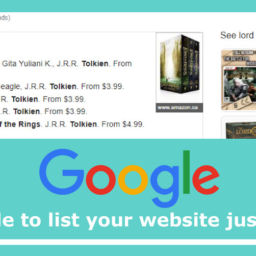Google is not an ecommerce website like the giant Amazon, but 35% of all product searches in the world starts with a google search.
Adding structured data to product pages is that relevant?
If you own an ecommerce website or planning on having one for your business, this is goodnews! It means that by adding structured data to product pages, your website have as much as a chance to be found by Google searchers. If you are careful enough to build your product content pages the way Google likes it to be structured, you can tap into that huge market of customers searches.
How is adding structured data to product pages being done?
Add markup to your product pages so Google can provide detailed product information in rich Search results — including Google Images, offers, product and prices, your reviews, your product availability needs to be structured like so. Users can see price, availability, and review ratings right on Search results.
Check our this example for shoptech.media on how a simple page rating review gives a rich snippets result in google search.

The article is found here. Shopify, Prestashop, ThirtyBees. Which eCommerce System to Use?
Scroll down to the bottom of the post to see the ratings. Things like that provide a huge different for your content, as far as credibility is concerned. Searchers will most likely click on that link than the one that don’t have the rating.
According to this report by searchengineland.
Product ratings can be incredibly helpful to users. During our research studies we’ve observed how the test subjects rely on ratings to gauge a product’s quality or value – especially in verticals where they lacks domain knowledge or have little prior product experience.
Why is it important to add structured data to product pages properly for Google and other search engines?
Use markup to enable rich product results. It lets you attract potential buyers while they are searching for items to buy on Google or images that include products you sell. Maintain the accuracy and freshness of your product information, so your customers find the relevant, current items they’re looking for.
This post will explain how to mark up your product information so that Google can display rich results. There are two types of product pages where you would typically use this markup:
- You product page that describes a single product.

- a shopping aggregator page that lists a single product, along with information about different sellers offering that product.

Adding structured data to product pages enables a badge on the image in mobile image search results, which can encourage more users to click your content.
What are Google’s guidelines in adding structured data to product pages?
Product rich results provide users with information about a specific product, such as its price, availability, and reviewer ratings. The following guidelines apply to product markup:
- Use markup for a specific product, not a category or list of products. For example, “shoes in our shop” is not a specific product. See also our structured data guidelines for multiple entities on the same page.
- Adult-related products are not supported.
- Reviewer’s name needs to be a valid name for a Person or Team For example, “James Smith” or”CNET Reviewers.” By contrast, “50% off on Black Friday” is invalid.
What if I want to include my images in the markup, can i do that?
Absolutely Yes. Google loves images to be included in your markup. Below is the guideline how to do it. To include product information in Google Images, follow these guidelines for required markup:
- Include the name, image, price, and priceCurrency properties.
- To show your product information in the Related Items feature: Include the name, image, price, priceCurrency, and availability properties.
Why are Images important to Google search?
The following statement are taken from Google developers page:
The URL of a product photo. Pictures clearly showing the product (for example, against a white background) are preferred. This property is required for Google Images and recommended for Google Search.
So, clearly, google places a lot of premium on contents that includes images.
Here is the rules we find at the google developers page regarding images in your contents:
- Every page must contain at least one image (whether or not you include markup). Google will pick the best image to display in Search results based on the aspect ratio and resolution.
- Image URLs must be crawlable and indexable.
- Images must represent the marked up content.
- Images must be in .jpg, .png, or. gif format.
- For best results, provide multiple high-resolution images (minimum of 50K pixels when multiplying width and height) with the following aspect ratios: 16×9, 4×3, and 1×1.
Images plays a very crucial role in your rich content being displayed by Google. Although, as far as I’ve observed, product images and videos do not appear in Google’s search results that often, they appear in many search results. Google determines that, and a big factor for that is how the images markup are structured.
Another theory I can think of is that, this is probably because, unless one is searching for something very specific, most results pages have multiple products, and Google can’t choose just one image or one video to represent the entire group of items.
However, if we are talking about a page that features an individual product, an image/video rich snippet is more likely to appear. Like below:

What are other important areas of my e-commerce that needs to have structured data implemented?
Offers comes to mind right away. If your website is offering coupon code for customer purchases. Let’s check for example if your search for coupon codes offers in 2019:

wired.com websites on the search results have done a marvelous job implementing structured data on their product page, beating out offers.com which came up second in the search results.
This is how it looks if we peep into the code, we can see that the site utilizes the Offer Schema to highlight the offer specifics:

Add structured data to product name and price
You can also improve your search result by structuring your markup for the product name and price of your product. If you search for the keyword “micro-cut shredder price”, the following result is displayed:

Structured data markup really helps your ecommerce content in Google search is the product availability. Availability is a product property characteristic that is good to mark up on an ecommerce website. The ItemAvailability Schema allows one to specify a variety of properties that may apply to merchandise:


The code will look like this:
<link itemprop=”availabiity” href=”https://shoptech.media/wp-content/uploads/2019/08/InStock”>
Google developers has this to say,
The value is taken from a constrained list of options, expressed in markup using URL links. Google also understands their short names (for example InStock or OutOfStock, without the full URL scope.) This property is required for the Related Items feature in Google Images and is recommended for Google Search.
In conclusion
Adding structured data to product pages is a necessity! It has been years since Google have recommended using Schema over other available structured data formats, using Schema.org/ on your page would be your best bet to rank better in Google search. Implement structured data markup to your product images, product name, product price, and product availability.
Having these four important aspect of your product page markup the way Google want it be structured goes a long way to having your ecommerce website ranking better in seach engines.
Once again let me know what you think in the comment section.










